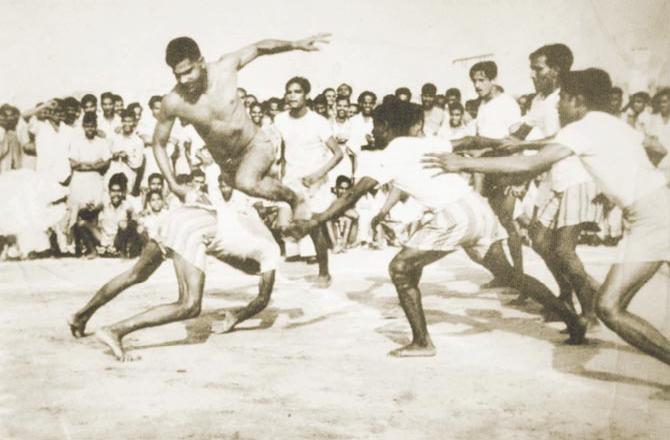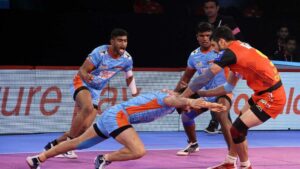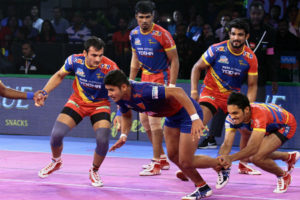History of Kabaddi:- It is a fascinating game the battle between the belligerent raiders and resolute defenders leaves the spectators spell-bounded. The high-octane action of the game never fails to mesmerize the fans and the viewers. Although the popularity of the game in the country and worldwide has been on the rise since the inception of the Pro Kabaddi League, most of the fans still have no idea about the origin of the Kabaddi.
Basics of Kabaddi
It is a combative sport, with seven players on each side. The game is played for a period of 40 minutes in 2 halves of 20 minutes each with a 5 minutes break (20-5-20). The core idea in the game of Kabaddi is to out-scoring the opponent on the scoreboard. The points can be scored by raiding into the opponent’s court and touching as many defensive players as possible in the opposition half without getting caught in a single breath. The other way to score points is to capture the raider in your half and stopping him from crossing the half line in the court.
One raider, chanting kabaddi-kabaddi Charges into the opponent’s court and try to touch the defenders, while the opponents make maneuvers to catch the raider. Kabaddi is also known as the game of struggle because one player has to go against the maximum of seven players at a time.
The players on the defensive side are called ‘Defenders’ while the player on the offense is called the ‘Raider.’ The process to attack the opposition in Kabaddi is known as a ‘Raid.’ The defenders touched by the raider during the raid are declared ‘out’ if they do not succeed in stopping the raider before he crosses the half line. These players can be revived to play only when their side scores points against the opposition during their raids or by catching the opponent’s raider.
Kabaddi in Indian Mythology
It is also mentioned in Indian Mythology. Hindu mythological epic, ‘The Mahabharata’ has the most noteworthy mention of Kabaddi in it. According to the legend, Pandava warrior Arjuna learned the skills and tricks of Kabaddi under the tutelage of Lord Krishna. He gained the mastery in the art of sneaking into enemy traps quietly and demolishing the fortifications of the enemies’ nonchalantly.
The epic also tells us about the tragic death of the brave warrior Abhimanyu, who got successful in piercing the ‘Chakravyuha’ or the seven-tiered defensive wall designed by the Kauravas during the Kurukshetra War but unfortunately did not know the way out of the Chakravyuha.
It is said that Abhimanyu was the son of Arjuna and he learned the technique of attacking at Chakravyuha when he was a fetus in Devi Subhadra’s womb. He absorbed the knowledge and skills to destroy the Chakravyuha when his father, Arjuna, was narrating the technique to his mother. However, Arjuna was called by Lord Krishna during the conversation, which deprived the unborn Abhimanyu the knowledge of escaping from the deadly and challenging formation.
On the 13th day of the Kurukshetra battle, when called upon, the 16-year-old Abhimanyu busted through the rigid form of the Kauravas in a glittering show of valor and fearlessness. The teenager fought gallantly, but ultimately he was mercilessly killed by the enemy brigade as he could find his way out from their iron clutches.
As per the ancient script, the sport of Kabaddi was established in memory of Abhimanyu to honor his bravery.
Kabaddi in Buddhist literature
Another mention of Kabaddi can be found in Buddhist literature too, which further establishes the fact that the game of Kabaddi has always been played and practiced with much enthusiasm in ancient India. Lord Gautam Buddha himself was one of the early ambassadors of the game, and he religiously promoted the game and also played it with his peers
Kabaddi in Pre Historic times
Since the prehistoric times, sports are considered as one of the principal too for the entertainment of humans. According to the studies, people in ancient civilizations such as Chinese, Indus, Greek, Egyptians, and Mesopotamia always considered sports as an essential part of their lifestyle. In the modern era, the significance of sports has reached to a whole another level.
It is also famous by different names such as Hututu, Do-do, and Ghidugudu in the different regions of the Indian Sub-continent. It is an ancient game based on mass group strategy which is played in most of the countries in South East Asia. In Bangladesh, it is popularly known as Hadudu, in Sri Lanka as Gudu, in Indonesia as the Chub, as Kabaddi in India and Pakistan. It has been one of the traditional outdoor rural sports in Bangladesh. Kabaddi surprisingly is the national sport of Bangladesh. The sport is also popular in Nepal, South Korea, and Japan.
In our country, sports have always been an important part of our culture. In the Vedic texts, there is a mention of various sports like horse riding, hunting, and wrestling. In the epic age, different team games such as Kabaddi and hide and seek came into the fold and became famous. In the modern era, technical games developed due to technological advancements. Many sports like cricket, baseball, hockey, tennis, basketball, volleyball, football, etc. evolved after the advent of western civilization.
It is originally a team sport which was originated from Tamil Nadu, India. There is concrete evidence that the game is 4,000 years old and the origin of the game of Kabaddi can be traced to prehistoric times; the game of Kabaddi took birth when humans learned the art of defending in groups against animals. They used to hunt weaker animals individually or in groups for their survival and food, and the same sort of skills was required to play the game of Kabaddi. According to the popular beliefs, the story of the origination of Kabaddi begins by a boy hitting another boy and running for candy. The boy who was hit chased the boy who hit him before hitting back and running away. So from here, the idea for a new exciting game of Kabaddi originated. Holding the breath during the raid was an added element with many other rules and regulations as the modern game of Kabaddi evolved.
Kabaddi and the Berlin Olympics
Kabaddi gets its first international exposure in Berlin Olympics during the Hitler regime. In 1936, a 35-member contingent from a lesser-known institute in Amravati, the Hanuman Vyayam Prasarak Mandal (HVPM) got the invitation to the Berlin Olympics to display to give demonstrations of mallakhamb and Kabaddi.
The players performed spectacularly well at the Congress of Physical Education in Berlin and exceeded the expectations of the audience right before the mega quadrennial Games. The audience was left mesmerized by the level of Indian martial art forms, and team’s scintillating display received praised from every corner of Europe. Most of the European regional papers gave rave reviews to the performance of the Indian team.
As the word spread, it reached the ears of Hitler’s minister Joseph Goebbels, who then convinced the Fuhrer to grant the Indian contingent a 20-minute audience to display their talent and the game of Kabaddi. The Indian contingent was presented with a medal of appreciation on the concluding day of the Berlin Olympics.
Kabaddi in Different Regions of India
From the early times, Kabaddi has been a significant part of the tradition of modern India. It has earned itself different names in the different regions of the country. In Tamil Nadu, it is known as Kabaddi or ‘chadukudu,’ in Andhra Pradesh, it is prevalent as, ‘chedugudu.’ In the north in Punjab, it is got a name ‘kauddi,’ and in the eastern part of the country, it is popular as ‘hu-tu-tu.’
Even in countries like Bangladesh and Maldives, the game of Kabaddi has equal importance, and it is known there as ‘hadudu’ and ‘bhavatik’ respectively.
As we know it, Modern Kabaddi is a synthesis of all these forms. With such a rich heritage and vast history the game has, it was thus not a surprise when Kabaddi was rightfully honored and identified as one of the national sports in 1918. It was the first of the baby-steps which were taken towards making Kabaddi a mainstream sport.
The first set of rules and regulations were formulated in 1921; however, it got authorized three years later in 1923. In the same year, the first All India Kabaddi Tournament was organized in Baroda.
With the increasing popularity of the game, a steady influx of players, and regular national-level tournaments, the game caught the pace and pervaded throughout the country. India then didn’t take much time in becoming a major powerhouse of the sport, and the next step was to provide the game much required international exposure.
The AIKF and AKFI and their roles
The modern game of Kabaddi has been played all over India and in some parts of South East Asia from 1930. In 1921, the first known framework of the rules and regulations of Kabaddi as an indigenous sport of India came into the fold, and it was prepared in Maharashtra for Kabaddi competitions. The set of rules and regulations was framed on the pattern of Sanjeevani and Gemini, two ancient forms of Kabaddi. In the year 1923, a committee was constituted which amended the rules framed in 1921, and after that, the revised regulations were applied to the All India Kabaddi Tournament which was organized in the same year 1923.
In 1950, the All India Kabaddi Federation was formed to look after the promotion of the game in the country and the Senior National championship was introduced from the year 1952. Later in 1972, the new body, Amateur Kabaddi Federation of India (AKFI) came into existence, and it also got affiliated to Indian Olympic Association (IOA) to promote the game of Kabaddi in India and the neighboring countries of Asia as well. After the formation AKFI, Kabaddi started to take a new shape as various National level competitions started for both male and female categories at different levels of Senior, Junior, and Sub-junior Kabaddi.
In the year 1980, the 1st Asian Kabaddi Championship was held, and later the efforts of AKFI finally paid off in 1982 when Kabaddi was included as a demonstration game in the 9th Asian Games, New Delhi that year.
In 1984, Kabaddi was recognized by the South Asian Federation (SAF), and it was included in SAF games at Dacca, Bangladesh. Later in 1990, Kabaddi was included as a discipline in the 11th Asian Games Beijing where India won the lone Gold Medal of Kabaddi. India is the reigning champion and only country to win the gold in the succeeding Asian Games held in Hiroshima 1994, Bangkok 1998, and Busan 2002 and recently at Doha 2006. When India won the Kabaddi gold in Doha, they created history in Indian sports by winning five consecutive Gold medals in the Asian Games.
In 2004, the first ever World Cup of Kabaddi was organized at Mumbai (India) where India lifted the World Cup trophy by beating Iran in the finals. In 2007, the second edition of the Kabaddi World Cup was held Panvel (India) where India once again showed their supremacy on the court and lifted the trophy for the second time.
In 2005, the First Asian Women Championship was held at Hyderabad where India clinched the Gold Medal. In 2006, for the first time, Women Kabaddi was included in the South Asian Games held in Colombo, Sri Lanka, which was a massive moment in the Kabaddi history.
In the 15th Asian Games held at Doha [Qatar] 2006, for the very first time in the history of Asian Games, a separate indoor stadium was built for Kabaddi. Korean made puzzle mats were used to make the training & warming up courts and main field of play as well. A giant public screen was placed in the main court of play which displayed replays and the running score. Other than that, there were two ‘Tissot’ plasma scoreboards, and info terminals for the presentation crew, the media, and the ceremony crew also were provided.
The 15th Asian Games in Doha provided a well-deserved opportunity to Kabaddi to showcase the game to the Europeans and Australians who were present there in high numbers to organize the Asian Games. A considerable number of spectators belonging to European countries, Australia, USA, Western Asia, and the Mediterranean countries, who were present at the Asian games and saw the game for the first time, left very impressed with the simple rules and the pace of the sport. They were left desired to introduce the sport in their countries as well due to thrill the game of Kabaddi provides. Due to this good and positive exposure of Kabaddi, there are enormous possibilities for its future and development in the continents of Europe, USA, Australia, and Africa.
In 2007, Kabaddi also became a part of the 2nd Asian Indoor games which were held at Macau. Once again the Indian team made its mark in the competition by winning the Gold Medal. In 2008, both categories of Kabaddi, Men & Women were included in 1st Asian Beach Games, which was hosted by Indonesia at Bali. India clinched the Gold Medals in both categories of Men & Women events.
In the past 50 years, the game of Kabaddi has seen a gradual but significant change in the trends of the game. The game which once was considered a game of brawn is now viewed as a game of strategies and planning. With the introduction of mats, shoes, new techniques the game has rapidly becoming popular, and the changes in rules have made the sport more compelling than ever before. With lots of coaching and strategies; now, skilled players can defeat the more substantial players with better skills & techniques as it is no more a game of power alone.
Kabaddi in Modern Times
In 1980, the efforts of AKFI were reflected with the introduction of the first Asian Kabaddi Championship. Countries like Japan, Malaysia, Nepal, along with India and Bangladesh, participated in the championship. India emerged the first ever champions of the Asian Kabaddi Championship by prevailing over Bangladesh. This win also began India’s dominance in the major Kabaddi tournaments.
In 1990, the rapidly increasing popularity of the game in the Asian countries paved the way for its introduction at the Asian Games in Beijing, which gave Kabaddi a significant foothold in the sports realm.
Over the years, Kabaddi has been a part of school and university sports curriculums all over India. That may seem small but is a significant step in the direction of promoting the game within the country. It inculcates the benefits of Kabaddi in young kids and helps in motivating them to pursue the sport extensively.
With Kabaddi continuously getting popular among the masses, it has also got featured in many notable Bollywood films. The most notable names in that list include Little Buddha, Pardes, Badlapur Boys, and Tevar, among others.
Today, the game is pursued and followed widely all over the world. India has been the torchbearer of this sport, but now it is played with equal fervor in Bangladesh, Sri Lanka, Japan, Iran, Thailand, Korea, Malaysia, Australia, Argentina, China, Trinidad and Tobago, Canada, Indonesia, United Kingdom, and several other countries.
With the introduction of the Pro Kabaddi League in 2014, the popularity of the sport has blown the roof. The glitz and glamour, the razzmatazz, the branding, the packaging – all the ingredients have blended well to make kabaddi a game of masses. It is now a sport that everybody can readily connect to, building an even brighter future for the game and its exponents.













